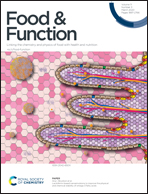Biofabrication, structure and characterization of an amylopectin-based cyclic glucan
Abstract
A novel amylopectin-based cyclic architecture was fabricated, arising from microbial branching enzyme treated waxy rice starch. The recombinant enzyme had a molecular weight of 72.0 kDa, and exhibited optimum activity at pH 7.0 and 75 °C. During the cyclization reaction catalyzed by a branching enzyme, the molecular weight of amylopectin rapidly decreased for the initial 2 h, and then very slowly decreased, tapering off at approximately 1.8 × 105 g mol−1 at 12 h. The number of A-chain fractions greatly increased, whereas the percentage of B-chain fractions decreased after enzymatic modification, accompanied by more α-1, 6 linkage formation. The core ring structure as a glucoamylase-resistant fraction had a number-average degree of polymerization of 21, which was constructed by 19 glucose units linked with, 2 glucosyl stubs at the O-6-position of the cyclic glucan through α-1,4 and α-1,6 linkages. Similar to large-ring cyclodextrin with equal glucose units, this cyclic glucan had a cavity geometry with two-circular loops and short stubs in perpendicular planes. Moreover, this cyclic glucan could complex with iodine for the host–guest formation. These results revealed the potential application of the amylopectin-based cyclic glucan as a good delivery system to encapsulate and protect bioactive ingredients.



 Please wait while we load your content...
Please wait while we load your content...